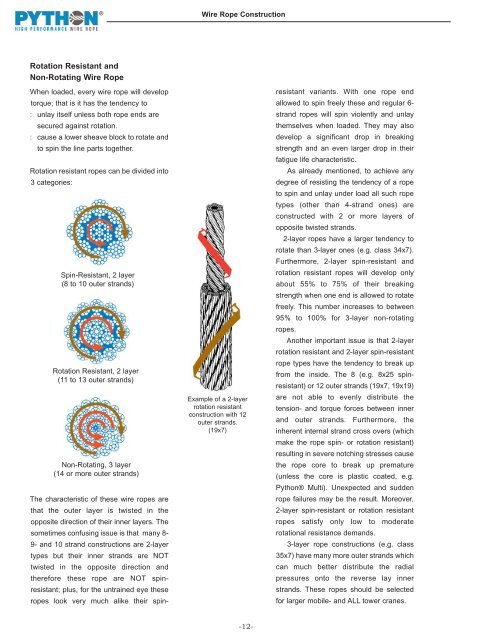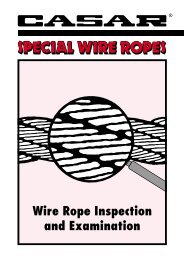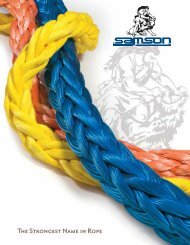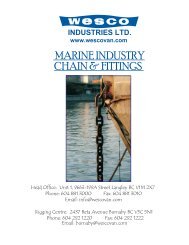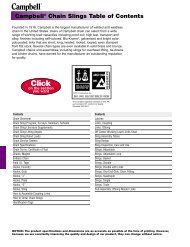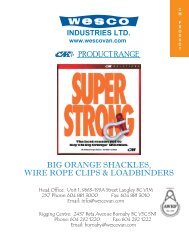Python Wire Rope - Wesco Industries Ltd.
Python Wire Rope - Wesco Industries Ltd.
Python Wire Rope - Wesco Industries Ltd.
Create successful ePaper yourself
Turn your PDF publications into a flip-book with our unique Google optimized e-Paper software.
<strong>Wire</strong> <strong>Rope</strong> Construction<br />
Rotation Resistant and<br />
Non-Rotating <strong>Wire</strong> <strong>Rope</strong><br />
When loaded, every wire rope will develop<br />
torque; that is it has the tendency to<br />
: unlay itself unless both rope ends are<br />
secured against rotation.<br />
: cause a lower sheave block to rotate and<br />
to spin the line parts together.<br />
Rotation resistant ropes can be divided into<br />
3 categories:<br />
Spin-Resistant, 2 layer<br />
(8 to 10 outer strands)<br />
Rotation Resistant, 2 layer<br />
(11 to 13 outer strands)<br />
Non-Rotating, 3 layer<br />
(14 or more outer strands)<br />
The characteristic of these wire ropes are<br />
that the outer layer is twisted in the<br />
opposite direction of their inner layers. The<br />
sometimes confusing issue is that many 8-<br />
9- and 10 strand constructions are 2-layer<br />
types but their inner strands are NOT<br />
twisted in the opposite direction and<br />
therefore these rope are NOT spinresistant;<br />
plus, for the untrained eye these<br />
ropes look very much alike their spin-<br />
Example of a 2-layer<br />
rotation resistant<br />
construction with 12<br />
outer strands.<br />
(19x7)<br />
resistant variants. With one rope end<br />
allowed to spin freely these and regular 6-<br />
strand ropes will spin violently and unlay<br />
themselves when loaded. They may also<br />
develop a significant drop in breaking<br />
strength and an even larger drop in their<br />
fatigue life characteristic.<br />
As already mentioned, to achieve any<br />
degree of resisting the tendency of a rope<br />
to spin and unlay under load all such rope<br />
types (other than 4-strand ones) are<br />
constructed with 2 or more layers of<br />
opposite twisted strands.<br />
2-layer ropes have a larger tendency to<br />
rotate than 3-layer ones (e.g. class 34x7).<br />
Furthermore, 2-layer spin-resistant and<br />
rotation resistant ropes will develop only<br />
about 55% to 75% of their breaking<br />
strength when one end is allowed to rotate<br />
freely. This number increases to between<br />
95% to 100% for 3-layer non-rotating<br />
ropes.<br />
Another important issue is that 2-layer<br />
rotation resistant and 2-layer spin-resistant<br />
rope types have the tendency to break up<br />
from the inside. The 8 (e.g. 8x25 spinresistant)<br />
or 12 outer strands (19x7, 19x19)<br />
are not able to evenly distribute the<br />
tension- and torque forces between inner<br />
and outer strands. Furthermore, the<br />
inherent internal strand cross overs (which<br />
make the rope spin- or rotation resistant)<br />
resulting in severe notching stresses cause<br />
the rope core to break up premature<br />
(unless the core is plastic coated, e.g.<br />
<strong>Python</strong>® Multi). Unexpected and sudden<br />
rope failures may be the result. Moreover,<br />
2-layer spin-resistant or rotation resistant<br />
ropes satisfy only low to moderate<br />
rotational resistance demands.<br />
3-layer rope constructions (e.g. class<br />
35x7) have many more outer strands which<br />
can much better distribute the radial<br />
pressures onto the reverse lay inner<br />
strands. These ropes should be selected<br />
for larger mobile- and ALL tower cranes.<br />
-12-


